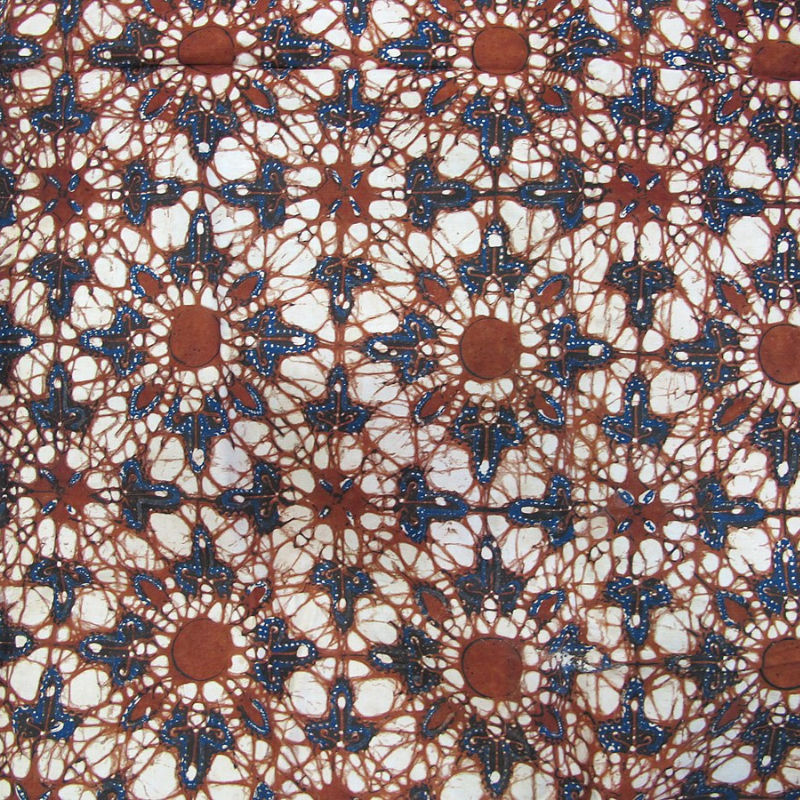Batik is a popular Indonesian art form, and a visit to any batik factory or store in the country is sure to delight you. Not only the colours and the patterns but also the fragrance batik artworks have is unique in itself. It has an interesting history, and you can also learn about the types of Indonesian batik designs through these visits.
According to scholars, it has different origins. The word batik is derived from ‘ambatik,’ meaning ‘a cloth with little dots’, where the suffix ‘tik’ means a small dot, point or drop. It may have also originated from the Javanese word tritik, referring to a resist process for dyeing. It includes giving the fabrics and textiles various designs, using tying and sewing methods before dyeing or waxing the cloth. The Javanese also call the making of batik as ‘mbatik manah,’ meaning ‘drawing a batik design on the heart’.
There are infinite variations of this intricate Indonesian art. Take a look at the history of batik and how it has been adapted in modern times.
A brief history of Batik
Batik prints have been a part of Indonesian heritage since the 5th century. The wax-resistant dyeing technique has been used to depict the entire human life cycle — birth, marriage and death — since then.
It was initially worn by royal families only, when special motif designations, known as batik parang, were assigned to each member of the lineage such as rulers, princes and noblemen.
Later, it depicted different provinces and social castes in the Asian country, through unique patterns.
More so, the Indonesian batik impressed everyone and continues to inspire many artisans and merchants across the world. Here’s how it has evolved over the years.
From 5,000 BC to 5th century
Samples of batik garments can be traced back to some Indian and Egyptian regions, where the textile was a part of trading. Interestingly, a proof of this was found by archaeologists in Pharaoh’s tomb, in the form of a wax indigo cloth dated around 5000 BC that indicated the use of wax in textile production back then.
The oldest batik textile (belonging to the 5th century) was found in the Toraja Regency on the Sulawesi island.
From 5th to 8th century
In this phase, the wax-resist dyeing technique was adopted and used in some Asian areas, like China and Japan.
During the Han (220-206 BC) and Sui Dynasty (AD 581-618) reigns, artisans in China largely used the batik techniques as a means of livelihood. Even today, one can find Chinese minorities like Miao, Bouyei and Gejia, based in the Guizhou province, still using traditional batik techniques to produce their fabrics.
In Japan, batik was extensively used by ancient textile artisans of the Nara Period (710-784) and the Heian Period (794-1185).
From 9th to 15th century
In this period, many textiles were traded between Indonesian royals and merchants from India, Arab and Gujarat. It is said that batik cloth was also bartered.
From 16th to 19th century
With the rise of Islamic kingdoms during this time, batik experienced many changes with respect to its philosophy and motifs. Some concepts having Hindu or Buddhist relevance were adapted to Islam, keeping the essence of the traditional motif intact. The purpose of this was to align the art with Islamic values, social customs and hierarchies prevalent during that era.
However, during the Dutch VOC (Vereenigde Oostindische Compagnie) era, towards the 20th century, Indonesian Javanese batik became an essential commodity for African and European merchants. Based on this, historians assumed that European colonials spread the wax-resist dyeing technique to other places in the world.
20th century onwards
Over the years, batik has become a common cultural practice, fostering relationships between countries in the South East Asia belt. They include Indonesia, Thailand, Singapore, Malaysia, Vietnam, Philippines, Brunei, Myanmar (Burma), Cambodia and Laos.
Owing to the efforts put forth by the Indonesians, batik was inscribed as UNESCO intangible cultural heritage of humanity, in September 2009. Through this inscription, many textile artisans across the globe are motivated to safeguard their cultural textile heritage.
Additionally, Indonesians are encouraged to wear batik clothes to connect with the nation’s heritage. And so, every Friday, you can see both locals and tourists donning beautiful batik garments with pride. Even people living elsewhere wear the intricately designed patterns on special occasions.
How is it used today?
Traditionally, batik was used to make sarongs, but due to the availability of more resources nowadays, artists create batik paintings, home furnishings, household accessories, tablecloths, cushion covers as well as exotic and modern sarongs.
In recent times, batik is customised as per the fabric and wax used. Traditional dyes have been replaced by chemical ones. Even the hand-written technique known as batik tulis has been replaced with batik cap, as per which special copper stamps are used to imprint batik on fabrics.
Apart from cotton, which is considered to be the main batik fabric, other fabrics used in the batik industry include silk, rayon and linen; traditional tools like Tjanting and Canting are supported by paint brushes and droppers in developing batik.
Also, various types of wax and pastes can be used to create batik patterns like microcrystalline wax, paraffin wax, pine resin, sugar syrup, plaster of Paris starches and Bengal gram flour or cold water starch.
(Hero and Featured Image Credit: Auckland Museum/ CC BY-SA 4.0 / Wikimedia Commons)
